| |
|
ASPEEC
Association de Soins Palliatifs pour l’Europe de l’Est et Centrale

Gyula Wárkonyi painter-artist
Gyula Wárkonyi was born on December 31st, 1947, in Szeged.
Szeged is only his birth place, as his family lived in the village
Sándorfalva. His father was a master blacksmith, his mother has
brought up five children. Gyula being the second of them. He is the
member of a humble and poor family, who spent the whole of his
youth in Sándorfalva, in beautiful Little Cumania.
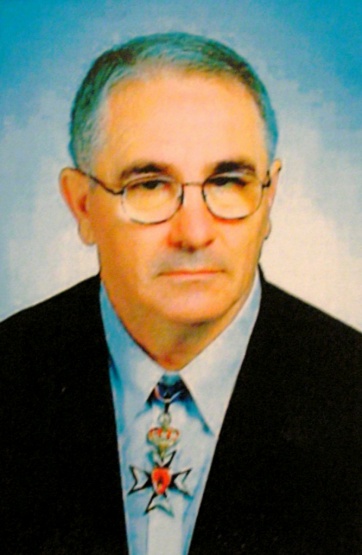 Little Cumania (Kiskunság) is one of the loveliest and most
colorful parts of the Great Hungarian Plain. It has a rich flora
and fauna, and a versatile population. It is the native land of silent
peasants, tough herdsman, rangeman and reckless highwaymen. All
this had hit lively and precocious child’s fancy, and he tried to
picture what he had seen, with hisplendid draughtsmanship.
Little Cumania (Kiskunság) is one of the loveliest and most
colorful parts of the Great Hungarian Plain. It has a rich flora
and fauna, and a versatile population. It is the native land of silent
peasants, tough herdsman, rangeman and reckless highwaymen. All
this had hit lively and precocious child’s fancy, and he tried to
picture what he had seen, with hisplendid draughtsmanship.
The smithy is the everyday meeting-place of the peasants of the
Plain. Hanging around the place, the child scampers about, helps
his father poke up the fire, or with his odd-later on more serious-jobs
day by day. The boy busies himself with horses, takes part in
shoeing them as well as in repairing wagons, ploughs, harrows and
other instruments. Meanwhile he keeps on listening to the never
ending talk of people about their everyday life and the way of the
world. A peculiar world conception is taking place in his mind: the
poor people’s simple and essential way of looking at things, and the
awareness that one has to work hard in order to earn one’s
livelihood.
Vulcan’s workshop is a hard school even for adults. It is not
without its dangers to be between a fiery foundry and kicking
horses. Gyula Wárkonyi not only saw but lived the life of the poor
as well. He would romp in the dust and clap his hands after heavy
showers together with the other children, and when he engaged
himself as a herdsman, he shivered with cold in the early morning
frost-bitten pastures, just like any other herdsman. Still, he does not
think of his childhood bitterly, as is obvious from his poems. For
he, being a man full of rhythm and harmony, sometimes writes
poems, too.
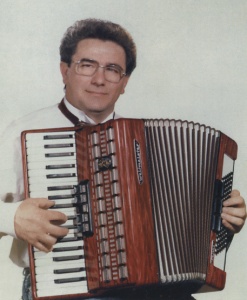 His talent for music also manifested itself quite early. In 1959 his
father bought him a piano accordion, which accompanied him
everywhere, from that time on. He became a musician and earned
his living an accordion player. Now he plays other, more serious
instruments as well, even if he has never had the possibility of
going to a school of music.
His talent for music also manifested itself quite early. In 1959 his
father bought him a piano accordion, which accompanied him
everywhere, from that time on. He became a musician and earned
his living an accordion player. Now he plays other, more serious
instruments as well, even if he has never had the possibility of
going to a school of music.
His draughtsmanship had been noticed by his teachers in the
primary school. The drawing-teacher István Lakatos, and his wife
were his first masters, who called his parents’ attention to the
child’s talent and suggested that the boy should continue studies.
The parents’ financial and social conditions, however, prevented
him from further studies. His father was rather unwell, especially
after the war, and the large family needed money at whatever cost.
Guyana helped to get some by all means. Poverty sometimes makes
even children resourceful. He would make music at wedding-feasts
and gatherings, draw and paint for neighbours and acquaintances
at little cost, engage himself as a herdsman. He has been
contributing all his earnings to the household budget ever since.
In the middle of the 60’s he wanted to learn a trade, and became
an industrial apprencite in Szeged. There, the painter-artist Károly
Vlasits, who enjoyed a high reputation, began to patronize
him. Vlasits was the head of an artist’s circle at that time. He taught
the gifted young boy how to draw and how to copy plaster figures.
Wárkonyi, a born peasant genius, kept away from the trends of
surrealism and cubism during his development, and has been
reluctant to follow any “isms” since then. He studied anatomy
through the shaping of plaster figures. His master was a strict,
taciturn man, who would only scold and never praise. Nevertheless,
it was obvious from his affectionate way of teaching that he took
the comprehensive training of his apprentice seriously. Little by
little, Gyula had learned how to use the pencil, and became
interested, in the secrets of brushwork. He was afraid of his master,
and had an affection for him at the same time. The thin, short,
skinny man seemed to control his pupils with his eyes.
Gyula had been taught by him for three years when the master
died. The semi-trained youth was deeply afflicted, so much the
more that the other painters in Szeged did not undertake to teach
him.
Then he began going to museums and exhibitions. Not finishing
the industrial school, he became a musician as he had to make a
living somehow. By night he would make music, by day go to
exhibitions, paint, train himself, and relax if there was any time left.
There usually was not too much to spare.
In 1968, he definitely moved to Szeged where he met his second
master, Sándor Siha, who strengthened his with to paint and to
become an acknowledged artist working not just for money but in
order to spread and pass on the beauty he had accumulated.
Sándor Siha was not a great artist but he was able to familiarize
his pupils with the great ones. He would speak about their works,
lives, struggles, their worlds of colours and shapes, the knacks of
brushwork, tints, tones and everything that is necessery for an
apprentice of painting to make progress. He looked on Gyula’s
pieces of work with a critical eye, and called his attention to his
mistakes. Sometimes he made him elaborate a picture several times
or repaint it in different variations. He showed him how to decípt
rivers, lakes and the sky. He made him see how much is hidden in
their relations to one another. In Gyula’s pictures were nets and
fish traps, magnificent sunsets alternated with radiant dawns. Bit by
bit, he began to find out how many possibilities are concealed in
the proper presentation of these alone.
During the same year he organized his first independent
exhibition in Pusztamérges, which was opened by the late painter-artist
from Hódmezővásárhely, Zoltán Fürtös. His and the
physician painter Dr. Árpád Bod’s suggestions gave the 21 year old
youth an exceptional stimulus. Of course, he was not perfect
yet. But he was making considerable progress along the path he
had set out on. And it was not easy without a flat and a studio of his
own, with no benefactors around. But slowly one can get far. He
was admitted to circle of fine arts working in the Club of Armed
Forces in Szeged.
There, at last, he was able to continue studies under an adequate
artistic guidance, without having to deviate from hid original line.
After having participated in several exhibitions of the circle. In
1977 he appeared at the Szeged Winter exhibition with his painting
“Trees”.
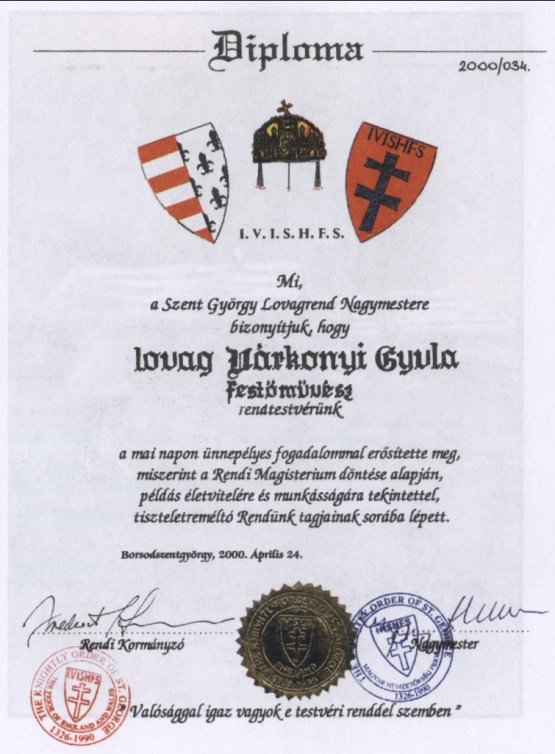
In 1978, he achieved considerable results in a creators’ camp
organized in Geszt, earning the appreciation of not only the local
people but the municipal council as well. The creators’ camp
worked under the direction of the painter József Nyári. In the Club
of Armed Forces, Wárkonyi’s artistic instructor was László
Zombori, a painter-artist from Szeged, who proved to be a strict
critic and a master with a strong hand. In the circle of fine arts
Wárkonyi had an opportunity to get acquainted with the “great ones”
in Szeged: István Dér, Sándor Fontos, the art painter-artist
Csaba Fejér, and many others, from whom he could get useful
advice and directives.
From that time on he would regularly take part in the exhibitions
of the circle, gradually changing over to organizing his own
exhibitions. His paintings are richly coloured and vivid, his way of
looking at things is exceptional, his mode of expression is
gorgeous. One might put it as “variations on a theme”.
This theme, however, is inexhaustible: the infinite quietude of the
landscape in the Great Hungarian Plain, the disappearing world of
scattered farms, the experience of childhood, the peasants
returning home from work. He not only saw but experienced it as
well. He knows what it means to sow by hand, how the hoers trudge
home at dawn, how the scythe-man moves at harvest time, how the
digger’s shoulders sink under the weight of the wheelbarrow, how
the mother bends over her child. The dead trees, the drought-stricken
fields are parts of him as well as winter woods or the
willows of the lake shore. He is happy in being born and brought up
here, being able to see and experience this all, and to pass it on in
ravishing pictures.
There is no need for Gyula Wárkonyi to see the landscape he
wants to depict. The pictures come from his soul, for he still lives
with the village where he was brought up. He feels that he will
never be able to give back everything he got from his native land.
His work and his exhibitions are appreciated by the local and
nationwide press alike. Articles regularly appear about him in the
newspapers “Délmagyarország” and “Szövetkezeti Híradó”. His
exhibitions are opened by writers, poets and artists. The writer
Imre Balázs has devoted a poem to one of his exhibitions.
Wárkonyi has been advised to break away from the past, and live
in the present, to look around, for there is enough to see, to say and
to express here as well. That is why he began to learn how to paint
portraits. He is not going to break away from the past, however. In
his paintings it still can be felt where he started from and what is
intended to be understood by the man of the present. He must see
what the lank game-keeper, the herdsman pondering by the fire, the
teenager girl washing her clothes in shabby basin, the young bride
adjusting her wreath, are like.
In 1980, the “Szövetkezeti Híradó” referred to Wárkonyi’s
unfavourable circumstances: they had been living in lodgings with
their baby, though the allocation of a flat to them had long been
overdue. There had been no changes in the painter’s life: making
music at night, sometimes up to a nervous breakdown.
He is an exceptionally fruitful painter, having several exhibitions
every year. The “Szövetkezeti Híradó” once called this a hobby but
it is not: it is a vocation. During the same year –
1980 – he won the
second prize in a competition for the cultural institutions of the
Hungarian People’s Army.
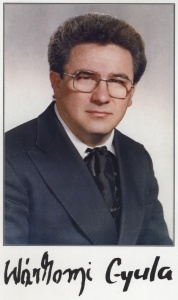 In 1981, he was again mentioned in the “Szövetkezeti Híradó” as
a musician and a painter, an expert in both these arts.
The real success, however, had not come until 1983, when he was
awarded the first prize in an exhibition of amateur artists in
Budapest. His prize-winning paintings were: “Trout-fly
pickers”, “Tramps”, “Spreading of
clothes”, “Winter”. Wárkonyi got
his flat only in 1983, but with only two rooms.
In 1981, he was again mentioned in the “Szövetkezeti Híradó” as
a musician and a painter, an expert in both these arts.
The real success, however, had not come until 1983, when he was
awarded the first prize in an exhibition of amateur artists in
Budapest. His prize-winning paintings were: “Trout-fly
pickers”, “Tramps”, “Spreading of
clothes”, “Winter”. Wárkonyi got
his flat only in 1983, but with only two rooms.
One was used as a very small studio, the other was the living-room
of the family, which then consisted of four members.
Nevertheless, he kept on working and creating with undiminished
energy. In September, 1985, he finally managed to open his
painting-school for children between 8 and 10 years of age, in the
Club of Armed Forces. He was extremely pleased with the
possibility of teaching.
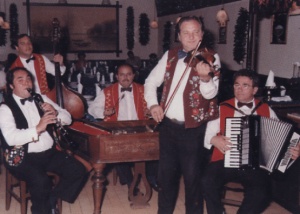 Gyula Wárkonyi is a man of a transitional age, who was being
brought to decline. He could see the lonely man in hid dilapidated
hut, the roofs that needed, thatching, the empty sties, shaky draw-wells,
dead trees and the aged population that stayed there. He now
has to say good-bye to that age, but he is doing it with a heavy
heart. There is nothing an artist can do against all that except for
showing the world what he had been, where we had come from,
how far our roots reach. And we do believe that this painter will get
from the Brook to the Ocean, to use the great Hungarian poet,
Endre Ady’s words.
Gyula Wárkonyi is a man of a transitional age, who was being
brought to decline. He could see the lonely man in hid dilapidated
hut, the roofs that needed, thatching, the empty sties, shaky draw-wells,
dead trees and the aged population that stayed there. He now
has to say good-bye to that age, but he is doing it with a heavy
heart. There is nothing an artist can do against all that except for
showing the world what he had been, where we had come from,
how far our roots reach. And we do believe that this painter will get
from the Brook to the Ocean, to use the great Hungarian poet,
Endre Ady’s words.
The first step towards the Ocean has been taken: in November,
1985, Gyula Wárkonyi was awarded the first prize at the Festival of
Fine Arts in Hamburg, West Germany.
|
|
| |